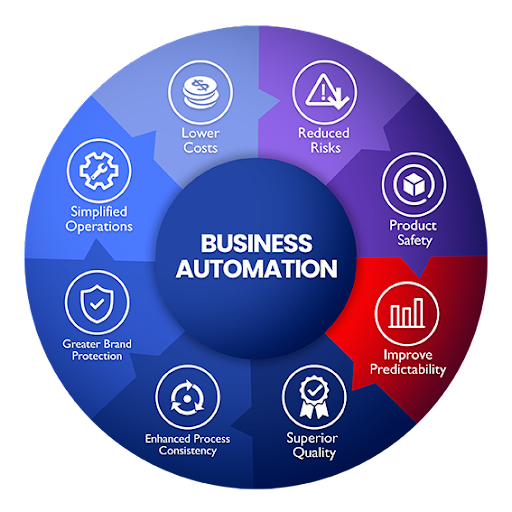Automation in Business Processes: Revolutionizing Efficiency and Productivity

In an increasingly competitive market, businesses are constantly searching for ways to improve efficiency, reduce costs, and maximize productivity. Automation in business processes has emerged as a game-changing solution, enabling organizations to streamline operations, eliminate redundancies, and focus on strategic growth.
This article explores the importance, benefits, and best practices of business process automation (BPA), offering insights to help you embrace automation as a vital aspect of your organizational strategy.
What is Business Process Automation?
Business Process Automation (BPA) refers to the use of technology to perform repetitive, time-consuming tasks with minimal human intervention. BPA reduces manual effort, minimizes errors, and enhances efficiency by automating workflows, from simple tasks like data entry to complex processes like customer relationship management (CRM).
Key Areas for Automation
- Finance: Invoicing, payroll, and expense tracking.
- Human Resources (HR): Employee onboarding, leave requests, and performance reviews.
- Customer Service: Chatbots, ticket resolution, and feedback collection.
- Supply Chain: Inventory management and order processing.
Why Automate Business Processes?

The digital revolution has made automation not just an option but a necessity for businesses that aim to thrive.
1. Increased Efficiency
Automation eliminates time wasted on repetitive tasks, allowing employees to focus on higher-value activities.
“Automated workflows ensure consistency and speed, enabling businesses to achieve more in less time.”
2. Cost Savings
By reducing manual errors and improving resource allocation, automation helps businesses save significant operational costs.
3. Enhanced Accuracy
Machines don’t make the same mistakes as humans. Automated systems improve data accuracy, ensuring better decision-making.
4. Improved Customer Experience
Automation ensures faster response times, personalized experiences, and seamless service delivery.
Learn More: How automation enhances customer service.
Top Benefits of Business Process Automation

1. Time Management
Automation tools like workflow software reduce time spent on routine tasks, enabling businesses to meet deadlines efficiently.
2. Scalability
As businesses grow, managing processes manually becomes challenging. Automation scales easily without a proportional increase in resources.
3. Employee Satisfaction
By eliminating monotonous tasks, automation lets employees focus on creative and meaningful work, boosting morale.
4. Data-Driven Insights
Automated systems generate valuable analytics, offering insights into operational efficiency and customer behavior.
Key Tools for Business Process Automation
Selecting the right tools is crucial for successful automation.
Popular Automation Tools
- Zapier: Ideal for integrating apps and automating workflows.
- UiPath: Robust tool for robotic process automation (RPA).
- HubSpot: Automates marketing and sales processes.
- Monday.com: Simplifies project management.
How to Choose the Right Tool
- Evaluate your business needs and scalability.
- Look for user-friendly interfaces.
- Ensure compatibility with existing software.
- Focus on customer support and reliability.
Pro Tip: Start with a trial version to ensure the tool meets your requirements.
Steps to Automate Business Processes

1. Identify Processes to Automate
Begin by analyzing workflows that are repetitive, error-prone, and time-consuming.
2. Define Objectives
Set clear goals for automation, such as reducing costs, enhancing productivity, or improving accuracy.
3. Select the Right Technology
Choose tools that align with your objectives and integrate seamlessly into your existing infrastructure.
4. Train Your Team
Provide comprehensive training to employees to ensure they can use automation tools effectively.
5. Monitor and Optimize
Continuously track performance metrics and refine automated workflows to maximize efficiency.
Challenges of Automation and How to Overcome Them
While automation offers numerous benefits, it’s not without challenges.
1. Resistance to Change
Employees may fear job displacement or struggle to adapt to new technologies.
Solution: Highlight the benefits of automation and involve employees in the transition process.
2. High Initial Costs
The upfront investment in automation tools and training can be significant.
Solution: Focus on ROI and choose scalable solutions that align with your budget.
3. Complexity of Implementation
Poorly planned automation can lead to disruptions.
Solution: Work with experts and start with a phased implementation.
Emerging Trends in Business Process Automation

1. Robotic Process Automation (RPA)
RPA uses software robots to perform high-volume, repetitive tasks.
2. Artificial Intelligence (AI)
AI-driven automation can predict customer behavior, optimize supply chains, and personalize marketing efforts.
3. Cloud-Based Solutions
Cloud platforms provide scalable and cost-effective automation tools accessible from anywhere.
Learn More: Benefits of cloud-based automation.
4. Low-Code/No-Code Platforms
These platforms allow businesses to create automated workflows with minimal technical expertise.
FAQs About Automation in Business Processes
Q1: What types of businesses benefit the most from automation?
A: Almost all businesses, from startups to large enterprises, can benefit. However, industries like manufacturing, healthcare, and e-commerce often see the greatest impact.
Q2: Is automation expensive to implement?
A: While initial costs can be high, the long-term benefits of cost savings, efficiency, and productivity outweigh the investment.
Q3: Will automation replace human jobs?
A: Automation is designed to complement human efforts, handling repetitive tasks while allowing employees to focus on strategic and creative work.
Q4: How secure is business process automation?
A: Leading automation tools prioritize data security with encryption and compliance standards.
Conclusion
Automation in business processes is no longer a luxury but a necessity for staying competitive in today’s dynamic marketplace. By embracing the right tools and strategies, businesses can streamline operations, reduce costs, and achieve sustainable growth.
Start your automation journey today—unlock efficiency and productivity like never before!

